The Grand Canyon is one of the world’s natural wonders, a region of vibrant archaeological history, unique wildlife, and breathtaking vistas. It’s definitely a place that should be on your bucket list of places to visit. Even though you can’t drive through the Grand Canyon as each part of the structure has to be conserved, you can still drive to and around the region, as well as to the entrances to the North and South Rims. In this article, we’ll share the best ways to drive to the Grand Canyon, the most scenic drives around the park, where to park and stay, and the best time to visit.
It’s important to know the best time to visit the different regions. The Grand Canyon’s operating hours vary depending on the season and the location, so it’s essential to keep up to date with the latest information before you embark on your trip.
Gateway cities and their distances to the Grand Canyon
This table provides information on the distance, commute time, and entrance for five gateway cities to help you plan your trip accordingly. Whether you’re traveling from Flagstaff, Phoenix, Las Vegas, Albuquerque, or Denver, this table will give you a good idea of what to expect in terms of travel time and distance.
| Gateway city | Distance (mi/km) | Commute Time | Entrance |
|---|---|---|---|
| Flagstaff, Arizona | 210 mi / 338 km | 3 hours 45 minutes | North Rim |
| Phoenix, Arizona | 240 mi 7 386 km | 3 hours 45 minutes | South Rim |
| Las Vegas, Nevada | 260 mi / 418 km | 4 hours 30 minutes | North Rim |
| Las Vegas, Nevada | 273 mi / 439 km | 4 hours | South Rim |
| Albuquerque, New Mexico | 400 mi / 643 km | 6 hours | South Rim |
| Denver, Colorado | 670 mi / 1078 km | 10 hours 30 minutes | South Rim |
Driving from Phoenix to the Grand Canyon

To reach the South Rim of the Grand Canyon from Phoenix, you can take a scenic drive that will take approximately 3 ½ hours. Starting your journey on I-17 North will lead you to the city of Flagstaff, which is one of the closest towns to the Grand Canyon. Along the way, you’ll be treated to stunning views of the Sonoran Desert as well as the Coconino National Forest.
Once in Flagstaff, you’ll take I-40 West, which will lead you to Williams, another gateway town to the Grand Canyon. Along the way, you can stop to explore historic Route 66 and take in the charming towns along the route. From Williams, you’ll turn right onto AZ-64/US-180 North, which will lead you straight into Tusayan and the entrance to the Grand Canyon National Park – South Rim.
See it on Google Maps (opens in a new window)
Driving from Las Vegas to the Grand Canyon (South Rim)

To get from Las Vegas to the Grand Canyon’s South Rim, you can take US-95 S/US-93 South towards Kingman, AZ, and then merge onto I-40 East towards Williams, Arizona. Once you reach Williams, take AZ-64 North/US-180 North, which will lead you straight to Tusayan and the entrance of the Grand Canyon National Park’s South Rim. The drive from Las Vegas takes approximately 4.5 hours, and along the way, you can enjoy the desert landscapes and mountainous terrain. Keep in mind that the route is quite remote, so it’s best to ensure you have enough fuel and supplies for the trip.
See it on Google Maps (opens in a new window)
Driving from Las Vegas to the Grand Canyon (North Rim)

If you’re traveling from Las Vegas to Grand Canyon North Rim, the best route to take is I-15 N, AZ-389 E, and US-89A S. This trip will take approximately 4 hours and 30 minutes and cover a distance of around 221 miles. Once you reach Coconino County, turn onto AZ-67 S, which will take you to your destination. However, note that AZ-67S may be closed at certain times or days. During winter, this road is closed at all times.
Be sure to check the road conditions and closures before you head out to avoid any inconvenience.
See it on Google Maps (opens in a new window)
Driving from Flagstaff to the Grand Canyon

If you’re planning to travel from Flagstaff, Arizona to Tusayan, Arizona, the most convenient route is to take I-40 West to AZ-64 North in Williams. Take exit 165 from I-40 West and then turn right onto AZ-64 North. Continue on this route for about 46 minutes or 49.7 miles until you reach Tusayan. This scenic route offers beautiful views of towering canyons and unique rock formations, so make sure to have your camera ready!
See it on Google Maps (opens in a new window)
Driving from Albuquerque to the Grand Canyon
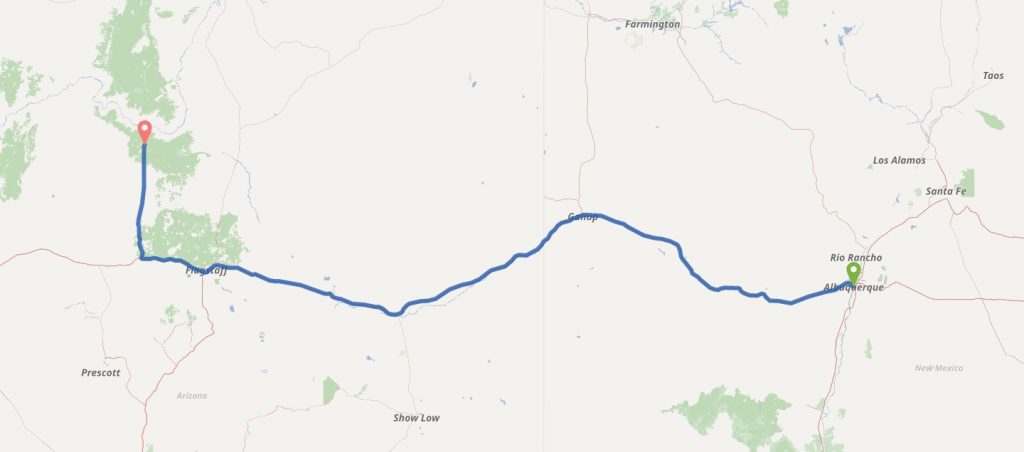
To reach Grand Canyon in Tusayan, Arizona from Albuquerque, New Mexico, you can take a 5-hour drive on I-40 W to AZ-64 N in Williams. Take exit 165 from I-40 W, and continue driving for 50 more miles on AZ-64 N to reach your destination in Tusayan. This route offers scenic views of the Arizona countryside and can be a relaxing drive for those who love road trips. Make sure to take adequate breaks during the journey and keep a check on the weather and traffic conditions to ensure a safe and comfortable trip.
See on Google Maps (opens in a new window)
Driving from Denver to the Grand Canyon

To reach Tusayan, Arizona from Denver, Colorado, take I-70 W, US-191 S, US-160 W and US-89 S to AZ-64 N in Williams. After driving for about 11 hours minutes covering 707 miles, take exit 165 from I-40 W and drive to AZ-64 N in Tusayan for about 1 hour, covering 52.6 miles. Finally, turn right onto AZ-64 N to reach your destination.
See it on Google Maps (opens in a new window)
Grand Canyon North and South Rim opening times
South Rim
The South Rim is open year-round and accessible 24/7. However, it’s important to note that some of the attractions may be closed during the winter months due to weather conditions. The South Rim Visitor Center is open every day from 9 am to 4 pm, allowing visitors to plan their visit accordingly.
North Rim
The North Rim, on the other hand, is only open to visitors from 15 May to 15 October, making it a more exclusive location to visit. During the operational season, the entrance to the North Rim is accessible 24 hours a day. The North Rim Visitor Center is open from 8 am to 5 pm during the months when the facilities are functional, providing visitors with ample time to explore the region.
It’s always a good idea to check with the U.S. National Park Service for the latest updates on operating hours and weather conditions before you head out to the Grand Canyon. This way, you can ensure that you make the most of your trip and don’t miss out on any of the amazing sights and experiences that this natural wonder has to offer.
Grand Canyon Entrances
We’ll give you an overview over all entrances to the Grand Canyon. There are three entrances in total – one located on the North Rim, two located on the South Rim. On the South Rim, you will find one close to the village of Tusayan, and the East Entrance located at the eastern end of the canyon.
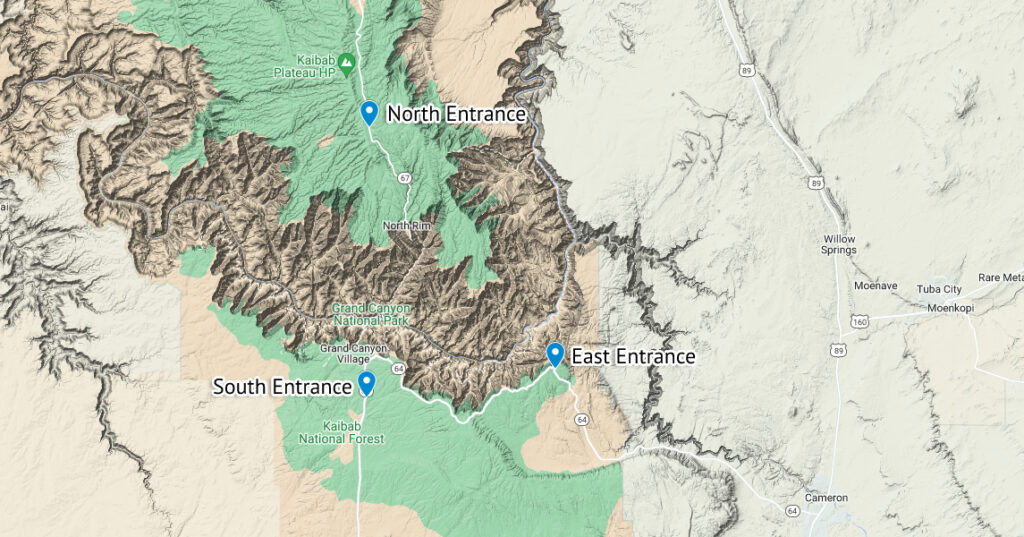
South Entrance
The south entrance to the Grand Canyon is close to the village of Tusayan and the Grand Canyon National Park airport. You reach it by driving 52 miles on the Route 64 / US Highway 180 northbound from Williams, AZ.
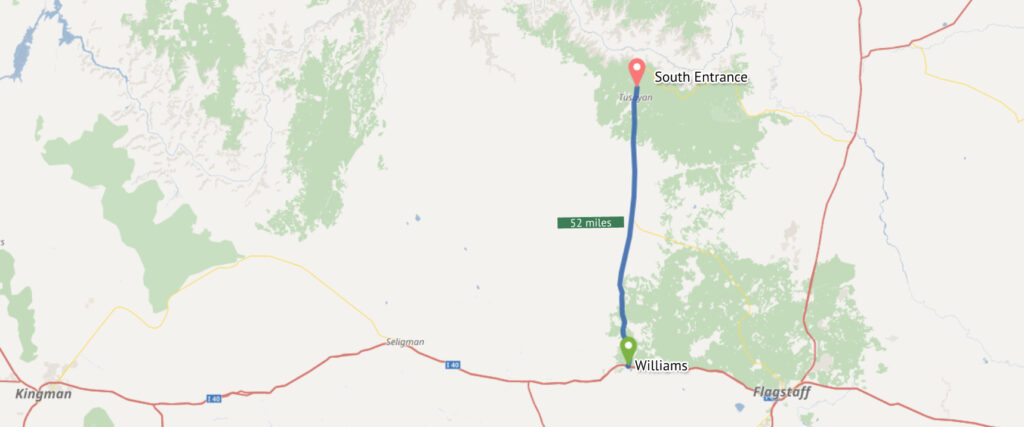
East “Desert View” Entrance
The eastern entrance, called “Desert View Entrance”, can be reached by driving westbound on the AZ 64 from Cameron, AZ. It’s a 30 mile trip to the East Entrance.

From the eastern entrance, you will travel along the Grand Canyon’s South Rim westbound until you reach the Grand Canyon village. This is another 22 mile trip.
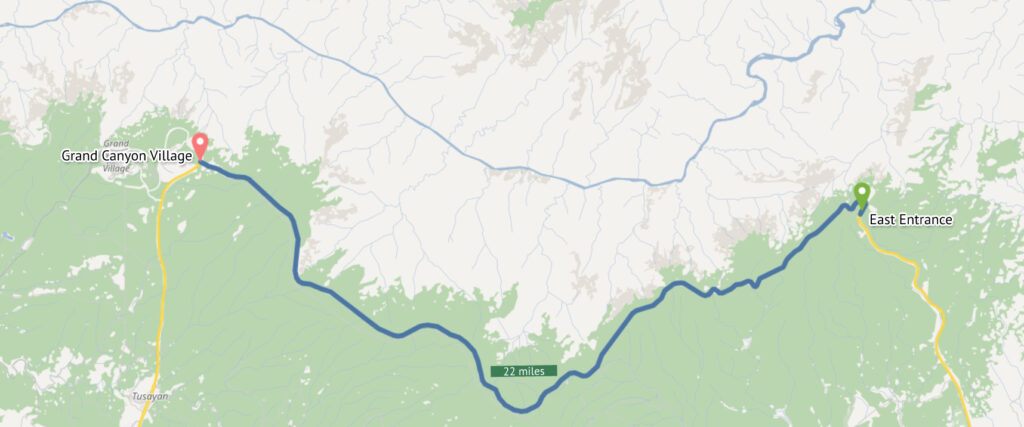
North Entrance
The northern entrance to the Grand Canyon is harder to reach than the other two. You can reach it by travelling down the AZ-67 S.
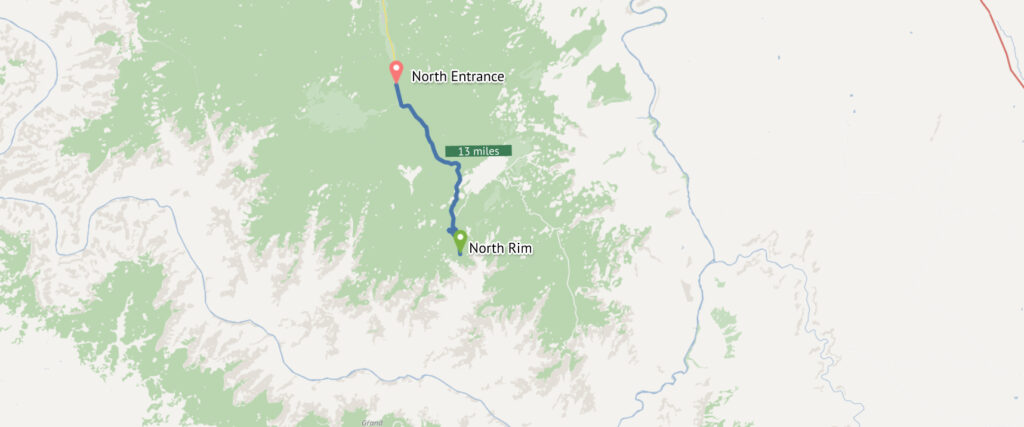
Entrance fees
If you’re planning to visit the Grand Canyon National Park, it’s important to know how much you’ll need to pay to enter and park. The cost of the entrance fee depends on the type of vehicle you’re using, and it’s the same for both the North and South Rims. It’s worth noting that only credit cards are accepted, and you can also purchase your entrance pass online to save time.
Here are the current fees for entrance and parking at the Grand Canyon National Park:
- 7-day individual park pass (for one person entering on foot, bicycle, shuttle, railway, etc.): $20
- 7-day motorcycle park pass: $30
- 7-day single-vehicle park pass: $35
- Annual Park Pass: $70 (valid for 365 days from the date of purchase and admits one private, non-commercial vehicle or its pass holder)
It’s important to note that the fees are subject to change, so it’s best to check the park’s website or contact the National Park Service for up-to-date information. Also, purchasing an annual pass can be a great option if you plan to visit the Grand Canyon multiple times throughout the year, as it offers significant savings compared to paying for individual entrance fees.
Grand Canyon Lodging
Accommodation near the Grand Canyon is plentiful and diverse, ranging from small towns to lodges and campgrounds. Gateway towns such as Flagstaff, Tusayan, Kingman, Williams and Page are all great options, depending on which Rim you plan to visit.
However, for the ultimate Grand Canyon experience, staying within the national park itself is a must. The park has a total of seven lodges, one on the North Rim and six on the South Rim, each offering their unique charm and amenities. The famous El Tovar Lodge, a registered national Historic Landmark, is located on the South Rim and is known for its one-of-a-kind architecture and design.
If you’re a nature enthusiast and want to be closer to the wilderness, the Grand Canyon’s campgrounds are perfect for you. The park has four campgrounds, with Mather Campground being the most popular. There are two campgrounds on the South Rim, one on the North Rim, and one on the East end of the region.
It’s important to note that accommodations within the park are highly sought-after, so it’s crucial to make reservations well in advance.
